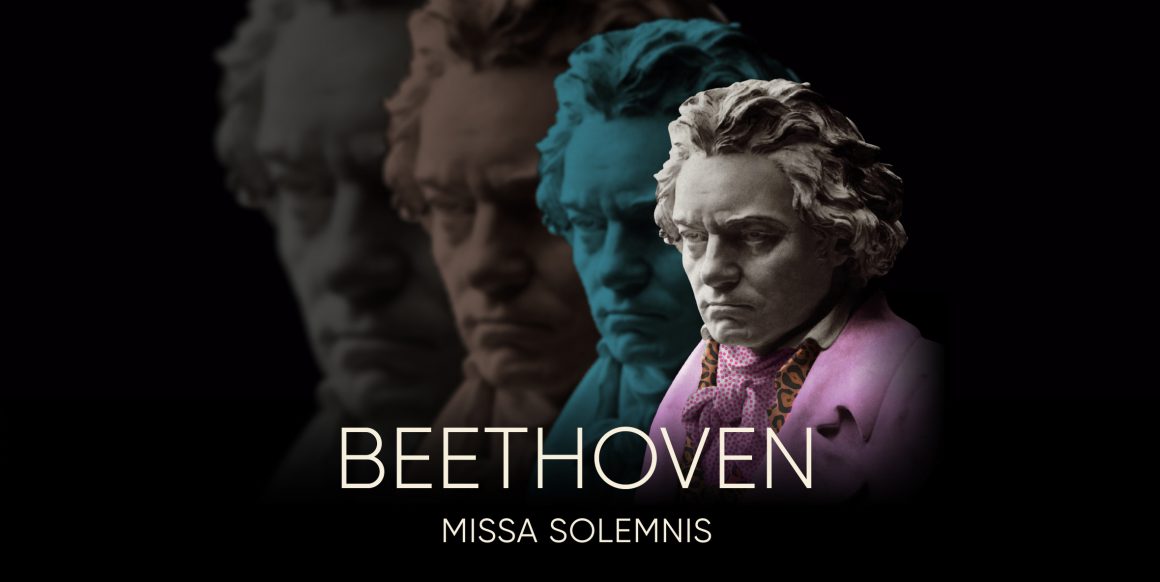The program notes are written by Rena Roussin, Musicologist-in-Residence.
“From the heart—may it return—to the heart.” After four years of compositional work, these are the words Ludwig van Beethoven inscribed on the score of his completed Missa solemnis before presenting it, in 1823, to his patron, pupil, and friend Rudolph Johann Joseph Rainer, Archduke of Austria. Originally commissioned to celebrate Archduke Rudolph’s investiture as Archbishop of Olmütz in 1819, Missa solemnis ultimately premiered in 1824 in St. Petersburg at a mysterious, little-documented benefit. The Mass had a partial Viennese premiere the same year. However, the full work was not premiered—in Vienna or elsewhere—until three years after Beethoven’s death, and recordings and performances of Missa solemnis remain, when compared against Beethoven’s other major late works, comparatively rare. Yet Beethoven counted his Mass as the greatest of his compositions, and his personal favourite. In addition to his inscription, the score is full of interpretive instructions he wrote for the musicians, among them “with devotion” and “asking for inner and outer peace.” Much evidence suggests, then, that Missa solemnis was, written from the heart, and is arguably one of Beethoven’s most personal and expressive compositions.
Yet in spite of (or, perhaps, because of) the Mass’s personal connection to Beethoven, it is notoriously challenging to contextualize within his sacred compositions. The composer only wrote two other large-scale sacred works: the 1803 oratorio Christ on the Mount of Olives and 1807’s Mass in C. Both differ radically from Missa solemnis. Some of this is surely due to issues of content, context, and time; the oratorio sets a completely different text and narrative; Mass in C was written for Joseph Haydn’s former patron Prince Nikolaus Esterházy II and inspired by (if not fully modelled after) Haydn’s late-period Masses; both works are characterized by aspects of Beethoven’s early and middle style. Yet there is also much reason to think that one of the reasons that Missa solemnis differs so radically from Beethoven’s earlier sacred works is because it functions, in many ways, as a statement or expression of faith, or, as music theorist Scott Burnham has suggested, as Beethoven’s most direct effort to musically depict the voice of God. Notably, Beethoven was baptized and raised Catholic, and though not a regular church-goer or practicing Catholic, maintained a life-long interest in concepts of God and spirituality.
To directly identify or explain any individual’s spiritual worldview and beliefs, particularly when that spirituality is expressed through art, is a daunting and complex task. Spirituality and faith, after all, deal primarily with the intangible and ineffable. Faith is ultimately meant to be felt and experienced and lived, but not necessarily retroactively analyzed. For these reasons—and because I want you, our audience, to feel free to bring your own diverse beliefs, ideas, and worldviews into dialogue with this extraordinary piece of music—I don’t want to speculate on what finer points of theology and Catholic or deist spiritual teachings Beethoven might be trying to communicate through Missa solemnis. When it comes to decoding musical meaning in the Mass, and Beethoven’s musical interpretation of its liturgical text, I will offer only one, objective hint: Beethoven composed the Mass simultaneously with his Ninth Symphony, and wove musical connections between them, originally intending for them to be performed in a double premiere. In that sense, then, the faith of Missa solemnis is meant to be in dialogue with the faith of Schiller’s words in the “Ode to Joy,” and their triumphant sense of belief in God and humanity alike.
The remarkably exacting musical demands of Missa solemnis also require faith (spiritual or otherwise). The original premiere in St. Petersburg was delayed by three months from Christmas of 1823 to early April of 1824 because the choir required more time to rehearse the extraordinarily difficult part-writing. Beethoven’s mass is defined, in part, by complex harmonies and extreme contrasts and sudden changes in metre, tempo, dynamic, and affect, all of which make the piece remarkably challenging to perform for singers and instrumentalists. Simultaneously, Missa solemnis broke historic nineteenth-century expectations of what a concert Mass was expected to sound like, with its addition of violin solo, recitative, and expressive additions to the standard Mass text. It also more than doubled the then-standard length of a concert Mass. This also means, however, that the Mass followed Beethoven’s standard compositional practice, as composition of Missa solemnis began after he had already defied standard compositional parameters of form and length in the sonata, symphony, and string quartet, reimagining in the process what all of those genres could be and communicate.
Finally, Missa solemnis also has a personal connection to the Toronto Mendelssohn Choir and its history, as the TMChoir gave the Canadian premiere of the piece in 1927. Almost a century later, as we celebrate the ending of our 130th anniversary season, it seems a fitting touchstone as a piece that brings together history, determination, innovation, complexity, faith, and a touch of the ineffable. On behalf of the choir and its leadership team, I want to offer our gratitude to you, our audience, both for your support of the choir over the years and for sharing this musical journey with us. We look forward to sharing music with you for many years to come!


